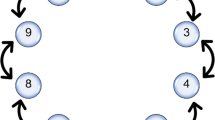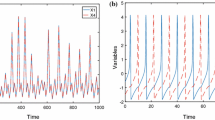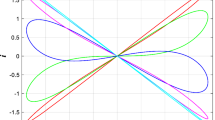Abstract
In this work, the synchronisation scenario and pattern formations are analysed in a network of modified Hindmarsh-Rose neurons arranged in a two-dimensional lattice. The coupling between neurons is nonlinear in nature and takes into account the distance between the neurons that form a square around it. The power law exponent strengthens the distance dependence. The study is carried out by varying coupling strength, distance dependence and coordination number. As the strength of the distance dependence of coupling increases, synchrony attains at a higher coupling strength. The analysis of the synchronisation scenario indicates that the synchronisation within a group is low and the synchrony between groups is high. The coupling threshold for attaining synchrony is determined by the coordination number and is not affected by the size of the network. As the coordination number increases, the synchrony attains at a weaker coupling strength. The stability of the synchrony is quantified using the Lyapunov function approach. Each group responds differently to the same coupling strength and the network shows interesting spatiotemporal patterns. The emergence of chimera and multichimera states is quantified using the strength of incoherence and discontinuity measure. This work sheds light on the coordination between and within layers of a complex system, including how different layers have unique responses to the same input. It also helps to understand how the interplay between coupling strength and distance dependence leads to the formation of interesting patterns.









Similar content being viewed by others
Data availability
The data that support the findings were generated from numerical simulations by the software MATLAB.
Code availability
Code for data simulation was developed by ourselves in MATLAB and will be made available on request.
References
Pikovsky, A., Rosenblum, M., Kurths, J., et al.: A universal concept in nonlinear sciences. Self 2, 3 (2001)
Boccaletti, S., Bianconi, G., Criado, R., Del Genio, C.I., Gómez-Gardenes, J., Romance, M., Sendina-Nadal, I., Wang, Z., Zanin, M.: The structure and dynamics of multilayer networks. Phys. Rep. 544(1), 1 (2014)
Fischer, I., Vicente, R., Buldú, J.M., Peil, M., Mirasso, C.R., Torrent, M., García-Ojalvo, J.: Zero-lag long-range synchronization via dynamical relaying. Phys. Rev. Lett. 97(12), 123902 (2006)
Bergner, A., Frasca, M., Sciuto, G., Buscarino, A., Ngamga, E.J., Fortuna, L., Kurths, J.: Remote synchronization in star networks. Phys. Rev. E 85(2), 026208 (2012)
Ma, J., Tang, J.: A review for dynamics in neuron and neuronal network. Nonlinear Dyn. 89(3), 1569 (2017)
Ma, J., Tang, J.: A review for dynamics of collective behaviors of network of neurons. Science China Technol. Sci. 58(12), 2038 (2015)
Gollo, L.L., Mirasso, C.R., Atienza, M., Crespo-Garcia, M., Cantero, J.L.: Theta band zero-lag long-range cortical synchronization via hippocampal dynamical relaying. PLoS ONE 6(3), e17756 (2011)
Wang, Q., Zheng, Y., Ma, J.: Cooperative dynamics in neuronal networks. Chaos Solitons Fractals 56, 19 (2013)
Huang, X., Troy, W.C., Yang, Q., Ma, H., Laing, C.R., Schiff, S.J., Wu, J.Y.: Spiral waves in disinhibited mammalian neocortex. J. Neurosci. 24(44), 9897 (2004)
Clauset, A., Newman, M.E., Moore, C.: Finding community structure in very large networks. Phys. Rev. E 70(6), 066111 (2004)
Moslonka-Lefebvre, M., Gilligan, C.A., Monod, H., Belloc, C., Ezanno, P., Filipe, J.A., Vergu, E.: Market analyses of livestock trade networks to inform the prevention of joint economic and epidemiological risks. J. R. Soc. Interface 13(116), 20151099 (2016)
Grimm, V., Revilla, E., Berger, U., Jeltsch, F., Mooij, W.M., Railsback, S.F., Thulke, H.H., Weiner, J., Wiegand, T., DeAngelis, D.L.: Pattern-oriented modeling of agent-based complex systems: lessons from ecology. Science 310(5750), 987 (2005)
Sprott, J.: Competition with evolution in ecology and finance. Phys. Lett. A 325(5–6), 329 (2004)
Woolley-Meza, O., Thiemann, C., Grady, D., Lee, J.J., Seebens, H., Blasius, B., Brockmann, D.: Complexity in human transportation networks: a comparative analysis of worldwide air transportation and global cargo-ship movements. Eur. Phys. J. B 84(4), 589 (2011)
Battiston, F., Nicosia, V., Chavez, M., Latora, V.: Multilayer motif analysis of brain networks. Chaos Interdiscip. J. Nonlinear Sci. 27(4), 047404 (2017)
Chouzouris, T., Omelchenko, I., Zakharova, A., Hlinka, J., Jiruska, P., Schöll, E.: Chimera states in brain networks: Empirical neural vs. modular fractal connectivity. Chaos Interdiscip. J. Nonlinear Sci. 28(4), 045112 (2018)
Ramlow, L., Sawicki, J., Zakharova, A., Hlinka, J., Claussen, J.C., Schöll, E.: Partial synchronization in empirical brain networks as a model for unihemispheric sleep. EPL (Europhys. Lett.) 126(5), 50007 (2019)
Kivelä, M., Arenas, A., Barthelemy, M., Gleeson, J.P., Moreno, Y., Porter, M.A.: Multilayer networks. J. Complex Netw. 2(3), 203 (2014)
De Domenico, M., Granell, C., Porter, M.A., Arenas, A.: The physics of spreading processes in multilayer networks. Nat. Phys. 12(10), 901 (2016)
Gambuzza, L.V., Frasca, M., Fortuna, L., Boccaletti, S.: Inhomogeneity induces relay synchronization in complex networks. Phys. Rev. E 93(4), 042203 (2016)
Vaiana, M., Muldoon, S.F.: Multilayer brain networks. J. Nonlinear Sci. 30(5), 2147 (2020)
Buzsáki, G., Moser, E.I.: Memory, navigation and theta rhythm in the hippocampal-entorhinal system. Nat. Neurosci. 16(2), 130 (2013)
Churchland, M.M., Cunningham, J.P., Kaufman, M.T., Foster, J.D., Nuyujukian, P., Ryu, S.I., Shenoy, K.V.: Neural population dynamics during reaching. Nature 487(7405), 51 (2012)
Boccaletti, S., Latora, V., Moreno, Y., Chavez, M., Hwang, D.U.: Complex networks: Structure and dynamics. Phys. Rep. 424(4–5), 175 (2006)
Hindmarsh, J.L., Rose, R.: A model of neuronal bursting using three coupled first order differential equations. Proc. R. Soc. Lond. Ser. B Biol. Sci. 221(1222), 87 (1984)
Wang, G., Yu, D., Ding, Q., Li, T., Jia, Y.: Effects of electric field on multiple vibrational resonances in Hindmarsh-Rose neuronal systems. Chaos Solitons Fractals 150, 111210 (2021)
Xu, Y., Wu, Y.: Analytical predictions of stable and unstable firings to chaos in a Hindmarsh-Rose neuron system. Chaos Interdiscip. J. Nonlinear Sci. 32(11), 113113 (2022)
Usha, K., Subha, P., Nayak, C.R.: The route to synchrony via drum head mode and mixed oscillatory state in star coupled Hindmarsh-Rose neural network. Chaos, Solitons Fractals 108, 25 (2018)
Usha, K., Subha, P.: Star-coupled Hindmarsh-Rose neural network with chemical synapses. Int. J. Mod. Phys. C 29(03), 1850023 (2018)
Xu, Y., Ying, H., Jia, Y., Ma, J., Hayat, T.: Autaptic regulation of electrical activities in neuron under electromagnetic induction. Sci. Rep. 7, 43452 (2017). https://doi.org/10.1038/srep43452
Xu, Y., Jia, Y., Ma, J., Hayat, T., Alsaedi, A.: Collective responses in electrical activities of neurons under field coupling. Sci. Rep. 8, 1349 (2018). https://doi.org/10.1038/s41598-018-19858-1
Majhi, S., Ghosh, D.: Alternating chimeras in networks of ephaptically coupled bursting neurons. Chaos Interdiscip. J. Nonlinear Sci. 28(8), 083113 (2018)
Wu, F., Zhang, Y., Zhang, X.: Regulating firing rates in a neural circuit by activating memristive synapse with magnetic coupling. Nonlinear Dyn. 98, 971 (2019)
Usha, K., Subha, P.: Hindmarsh-Rose neuron model with memristors. Biosystems 178, 1 (2019)
Usha, K., Subha, P.: Energy feedback and synchronous dynamics of Hindmarsh-Rose neuron model with memristor. Chin. Phys. B 28(2), 020502 (2019)
Usha, K., Subha, P.: Collective dynamics and energy aspects of star-coupled Hindmarsh-Rose neuron model with electrical, chemical and field couplings. Nonlinear Dyn. 96(3), 2115 (2019)
Vijay, S.D., Thamilmaran, K., Ahamed, A.I.: Superextreme spiking oscillations and multistability in a memristor-based Hindmarsh–Rose neuron model. Nonlinear Dyn. pp. 1–11 (2022)
Banerjee, T., Dutta, P.S., Zakharova, A., Schöll, E.: Chimera patterns induced by distance-dependent power-law coupling in ecological networks. Phys. Rev. E 94(3), 032206 (2016)
Gupta, A., Banerjee, T., Dutta, P.S.: Increased persistence via asynchrony in oscillating ecological populations with long-range interaction. Phys. Rev. E 96(4), 042202 (2017)
Sathiyadevi, K., Chandrasekar, V., Senthilkumar, D., Lakshmanan, M.: Long-range interaction induced collective dynamical behaviors. J. Phys. A: Math. Theor. 52(18), 184001 (2019)
Bandyopadhyay, B., Khatun, T., Dutta, P.S., Banerjee, T.: Symmetry breaking by power-law coupling. Chaos, Solitons Fractals 139, 110289 (2020)
Budzinski, R., Rossi, K., Boaretto, B., Prado, T., Lopes, S.: Synchronization malleability in neural networks under a distance-dependent coupling. Phys. Rev. Res. 2(4), 043309 (2020)
Remi, T., Subha, P., Usha, K.: Collective dynamics of neural network with distance dependent field coupling. Commun. Nonlinear Sci. Numer. Simul. 110, 106390 (2022)
Bera, B.K., Ghosh, D., Lakshmanan, M.: Chimera states in bursting neurons. Phys. Rev. E 93(1), 012205 (2016)
Kundu, S., Majhi, S., Bera, B.K., Ghosh, D., Lakshmanan, M.: Chimera states in two-dimensional networks of locally coupled oscillators. Phys. Rev. E 97(2), 022201 (2018)
Majhi, S., Bera, B.K., Ghosh, D., Perc, M.: Chimera states in neuronal networks: a review. Phys. Life Rev. 28, 100 (2019)
Ren, S.Q., Li, Z., Lin, S., Bergami, M., Shi, S.H.: Precise long-range microcircuit-to-microcircuit communication connects the frontal and sensory cortices in the mammalian brain. Neuron 104(2), 385 (2019)
Ang, E.S., Haydar, T.F., Gluncic, V., Rakic, P.: Four-dimensional migratory coordinates of GABAergic interneurons in the developing mouse cortex. J. Neurosci. 23(13), 5805 (2003)
Zhang, X.J., Li, Z., Han, Z., Sultan, K.T., Huang, K., Shi, S.H.: Precise inhibitory microcircuit assembly of developmentally related neocortical interneurons in clusters. Nat. Commun. 8(1), 16091 (2017)
Shima, S.I., Kuramoto, Y.: Rotating spiral waves with phase-randomized core in nonlocally coupled oscillators. Phys. Rev. E 69(3), 036213 (2004)
Grace, M., Hütt, M.T.: Predictability of spatio-temporal patterns in a lattice of coupled FitzHugh-Nagumo oscillators. J. R. Soc. Interface 10(81), 20121016 (2013)
Bukh, A., Strelkova, G., Anishchenko, V.: Spiral wave patterns in a two-dimensional lattice of nonlocally coupled maps modeling neural activity. Chaos, Solitons Fractals 120, 75 (2019)
Majhi, S., Perc, M., Ghosh, D.: Chimera states in uncoupled neurons induced by a multilayer structure. Sci. Rep. 6(1), 1 (2016)
Rybalova, E., Bukh, A., Strelkova, G., Anishchenko, V.: Spiral and target wave chimeras in a 2D lattice of map-based neuron models. Chaos Interdiscip. J. Nonlinear Sci. 29(10), 101104 (2019)
Xu, F., Zhang, J., Jin, M., Huang, S., Fang, T.: Chimera states and synchronization behavior in multilayer memristive neural networks. Nonlinear Dyn. 94(2), 775 (2018)
Kundu, S., Bera, B.K., Ghosh, D., Lakshmanan, M.: Chimera patterns in three-dimensional locally coupled systems. Phys. Rev. E 99(2), 022204 (2019)
Frolov, N.S., Maksimenko, V.A., Khramova, M.V., Pisarchik, A.N., Hramov, A.E.: Dynamics of functional connectivity in multilayer cortical brain network during sensory information processing. Eur. Phys. J. Spec. Top. 228(11), 2381 (2019)
Yao, Y., Deng, H., Yi, M., Ma, J.: Impact of bounded noise on the formation and instability of spiral wave in a 2D Lattice of neurons. Sci. Rep. 7(1), 1 (2017)
Shafiei, M., Jafari, S., Parastesh, F., Ozer, M., Kapitaniak, T., Perc, M.: Time delayed chemical synapses and synchronization in multilayer neuronal networks with ephaptic inter-layer coupling. Commun. Nonlinear Sci. Numer. Simul. 84, 105175 (2020)
Yan, B., Parastesh, F., He, S., Rajagopal, K., Jafari, S., Perc, M., et al.: Interlayer and intralayer synchronization in multiplex fractional-order neuronal networks. Fractals 30(10), 2240194 (2022)
Rakshit, S., Bera, B.K., Ghosh, D.: Synchronization in a temporal multiplex neuronal hypernetwork. Phys. Rev. E 98(3), 032305 (2018)
Drauschke, F., Sawicki, J., Berner, R., Omelchenko, I., Schöll, E.: Chaos: Effect of topology upon relay synchronization in triplex neuronal networks. Interdiscip. J. Nonlinear Sci. 30(5), 051104 (2020)
Tan, Y., Wang, C.: Chaos: A simple locally active memristor and its application in HR neurons. Interdiscip. J. Nonlinear Sci. 30(5), 053118 (2020). https://doi.org/10.1063/1.5143071
Shi, X., Wang, Z.: Adaptive synchronization of time delay Hindmarsh-Rose neuron system via self-feedback. Nonlinear Dyn. 69(4), 2147 (2012)
Belykh, I., De Lange, E., Hasler, M.: Synchronization of bursting neurons: what matters in the network topology. Phys. Rev. Lett. 94(18), 188101 (2005)
Pecora, L.M., Carroll, T.L.: Master stability functions for synchronized coupled systems. Phys. Rev. Lett. 80(10), 2109 (1998)
Dhamala, M., Jirsa, V.K., Ding, M.: Transitions to synchrony in coupled bursting neurons. Phys. Rev. Lett. 92(2), 028101 (2004)
Dhamala, M., Jirsa, V.K., Ding, M.: Enhancement of neural synchrony by time delay. Phys. Rev. Lett. 92(7), 074104 (2004)
Etémé, A.S., Tabi, C.B., Beyala Ateba, J.F., Ekobena Fouda, H.P., Mohamadou, A., Crépin Kofané, T.: Chaos break and synchrony enrichment within Hindmarsh-Rose-type memristive neural models. Nonlinear Dyn. 105(1), 785 (2021)
Yamakou, M.E.: Chaotic synchronization of memristive neurons: Lyapunov function versus Hamilton function. Nonlinear Dyn. 101(1), 487 (2020)
Gopal, R., Chandrasekar, V., Venkatesan, A., Lakshmanan, M.: Observation and characterization of chimera states in coupled dynamical systems with nonlocal coupling. Phys. Rev. E 89(5), 052914 (2014)
Acknowledgements
TR would like to thank UGC, India, for the research fellowship through MANF, and PAS would like to acknowledge DST, India, for the financial assistance through FIST program.
Funding
No funding was received to assist with the preparation of this manuscript.
Author information
Authors and Affiliations
Contributions
Both authors contributed to the study, conception and design. The work, data simulation and analysis were performed by T. Remi. P. A. Subha made substantial contributions to the conception or design of the work.
Corresponding author
Ethics declarations
Conflict of interest
The authors declare that they have no conflict of interest.
Additional information
Publisher's Note
Springer Nature remains neutral with regard to jurisdictional claims in published maps and institutional affiliations.
Rights and permissions
Springer Nature or its licensor (e.g. a society or other partner) holds exclusive rights to this article under a publishing agreement with the author(s) or other rightsholder(s); author self-archiving of the accepted manuscript version of this article is solely governed by the terms of such publishing agreement and applicable law.
About this article
Cite this article
Remi, T., Subha, P. . Memristive Hindmarsh-Rose network in 2D lattice with distance-dependent chemical synapses. Nonlinear Dyn 111, 14455–14466 (2023). https://doi.org/10.1007/s11071-023-08542-3
Received:
Accepted:
Published:
Issue Date:
DOI: https://doi.org/10.1007/s11071-023-08542-3




